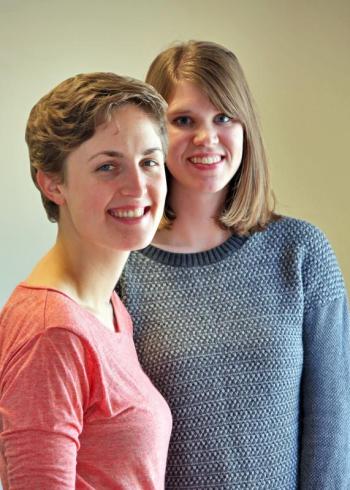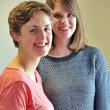Medical school students learn to focus on whole patient
 Maine Medical Center – Tufts University School of Medicine Maine Track Students Jennifer MacDowell, left, and Valerie Smith say one of the most important lessons they have learned at LincolnHealth over the past eight months is the importance of understanding the patient as a whole person. Courtesy photo
Maine Medical Center – Tufts University School of Medicine Maine Track Students Jennifer MacDowell, left, and Valerie Smith say one of the most important lessons they have learned at LincolnHealth over the past eight months is the importance of understanding the patient as a whole person. Courtesy photo
 Maine Medical Center – Tufts University School of Medicine Maine Track Students Jennifer MacDowell, left, and Valerie Smith say one of the most important lessons they have learned at LincolnHealth over the past eight months is the importance of understanding the patient as a whole person. Courtesy photo
Maine Medical Center – Tufts University School of Medicine Maine Track Students Jennifer MacDowell, left, and Valerie Smith say one of the most important lessons they have learned at LincolnHealth over the past eight months is the importance of understanding the patient as a whole person. Courtesy photo
Valerie Smith’s journey to medical school began in an ambulance at the beginning of her junior year at the University of Maine at Orono.
A friend had talked Valerie into becoming an emergency medical technician and that fall night she had volunteered on the campus ambulance system for the first time. Her first patient was a freshman who dislocated his knee while playing basketball.
The young man was very uncomfortable and while she couldn’t offer him medication for the pain, she held his hand on the bumpy ride to the hospital. It made a difference to the patient and Smith was hooked. Over the next two years, she spent as much time as possible volunteering with the ambulance service.
“I realized that as much as I liked doing research and working in the lab, it was the personal connection and interaction with patients that I really loved,” said Smith.
Smith and fellow Maine Medical Center - Tufts University School of Medicine Maine Track Program student Jennifer MacDowell have spent the past eight months at LincolnHealth and other clinical locations, mostly in Lincoln County. They work closely with local providers caring for patients in the outpatient setting as well as assisting with births, observing surgeries and participating in care of hospitalized patients as part of an innovative program designed to draw promising future doctors to rural areas.
The Maine Medical Center - Tufts University School of Medicine program aims to address a critical shortage of physicians in rural Maine by bringing students with an interest in rural medicine to communities where they can develop the relationships that often lead them to return after they have completed their training.
This is the fourth year of LincolnHealth's participation in the Maine Medical Center-Tufts University School of Medicine program. The first class of students who spent the nine-month program at LincolnHealth are now in their residencies.
Heather Wolfe, Site Director for the program, said one of the very positive things about the program is the way not only the medical community but the broader community has accepted the students, allowing them to be a part of their medical care.
"As a community, we recognize and embrace the important responsibility and tremendous opportunity to nurture and shape the development of the physicians who will care for us in the future," said Wolfe.
Students work with mentor physicians and midwives and a panel of patients over the nine month program, following the same patients as they access care at different places in the healthcare system. In a more traditional curriculum, students focus on specialties as separate units and rarely see the same patient twice.
MacDowell, who is from Massachusetts but grew up spending summers at her family’s cottage in Casco, said being able to follow patients and even visit them in their homes has given her and Smith insight into the hurdles patients face accessing care and the difficult decisions they confront as they age.
“It is a different dynamic to go into a patient’s home and see their living situation and be in their world for half an hour and try to evaluate how to best provide care,” she said.
One older gentleman MacDowell met was living alone. It sometimes took him hours to get from his bed down the stairs to the kitchen for breakfast. He didn’t want to leave his home but he understood he could no longer live alone.
Sometimes the role of the physician is to work with patients as they face difficult choices and help them come to terms with the changing realities of aging, said MacDowell.
By following patients from the moment they first arrive in the Emergency Department through their stay in the hospital, Smith and MacDowell have been able to form relationships with patients and understand not just the clinical details of their disease but the hurdles they face in getting well.
Watching people as they prepare to go home after a medical crisis has helped the future doctors understand how difficult the transition home can be for a patient. Many have financial concerns about what their insurance will cover or how much their new medications will cost. Others are not sure how to follow their treatment plans.
“It kind of underscores how challenging it is for the patient to understand all this information that is being thrown at them,” said Smith. It is really important, she said, for providers to collaborate with patients, to try to figure out what is going to work best for them rather than just say “‘I am the doctor and here is the treatment plan.’”
Being able to get to know patients and follow their progress through the medical system has helped both students take a more holistic view of medicine. There is a lot more to making people well than just understanding how to cure their disease, they said.
“I have realized that when I am looking at patients, it doesn’t matter what office I am seeing them in, I am thinking about their mental health and their pains and aches and all the organs that could be related so I guess we are seeing the patient for all that they are,” said MacDowell.
“You have to be doing everything when you see any patient. You have to be thinking about the whole person,” said Smith.
Event Date
Address
United States






















